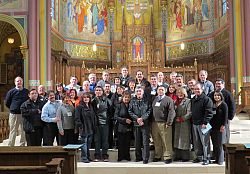19 men form the new permanent deacons class

SALT LAKE CITY — Nineteen men have begun an intensive four-year program to become permanent deacons for the Diocese of Salt Lake City. All of the men are Spanish-speaking or bilingual; in 2010 the diocese ordained 21 permanent deacons, most of whom were English-speaking.
The permanent diaconate is an ordained ministry. Unlike transitional deacons, who typically are men destined for the priesthood and therefore are celibate, permanent deacons may be married. They perform various sacramental functions such as weddings without a Mass, funerals and baptisms; they also assist at the Eucharistic liturgy.
Father Eleazar Silva, parochial vicar of the Cathedral of the Madeleine, was appointed Director of Academics for the program and Deacon Drew Peterson is the overall director.
Preliminary preparations for the program began last March.
"There were six inquiry sessions held all the way from Cedar City to Ogden, and 49 people came to those sections and submitted their forms," said Deacon Petersen, who was ordained a permanent deacon in 2010.
Serving as a deacon is a vocation, Fr. Silva said. "Vocations are a gift from the Holy Spirit; it is the Holy Spirit who calls you and tells you that you need to be in service to the church."
Of the 49 men who submitted forms for the program, 23 were selected to receive applications.
"All eligibility requirements are set by the Vatican and the United States Council of Catholic Bishops," said Deacon Petersen.
The applications were submitted in June; a committee then narrowed this group to 19.
Deacon Petersen and Father Silva then did home visits to each one of the selected men.
"We gathered with the husband and the wife and the children [if any]. From that point psychological evaluations were arranged," said Deacon Petersen, noting that one of the aspirants has never been married.
The candidates’ wives are encouraged to join their husbands during the training. Typically the wives are shown a video about the program, but Deacon Petersen couldn’t find a Spanish-language video.
"So we decided to create a reality show and in this one, two of the wives of our deacons who are Spanish speaking, Esperanza Arias and Vita Mota, met with all the wives and spend time with them," he said, adding that Arias and Mota explained how deacons’ wives help their husbands in their ministry.
"The diocese asked us to form deacons that will speak from their own point of view, so all the material have come from Latin America, but of course under the guidelines of the American Catholic bishops," said Fr. Silva.
"It is a call from God. He is always there to help them and we are going to give them as many tools as necessary," said Deacon Petersen.
An extensive report about each candidate that included information from pastors, fellow parishioners and employers then was submitted to Monsignor Colin F. Bircumshaw, the diocesan vicar general, who is also vicar for clergy.
Msgr. Bircumshaw reviewed the files, added his comments and submitted them to Bishop John C. Wester for final approval.
The 19 men had their first training class Jan. 19.
"The first period of the process is basically the first half year determining the eligibility, and the next eight months is the aspirancy period – spending more time discerning the call," Deacon Petersen said.
After the aspirancy period, the men become candidates. They will spend three years studying many aspects of the Catholic faith as well as gaining practical experience.
"Out of these 19 Catholic men, all are Spanish speaking, but three of them are not Hispanic, they are Anglo," said Fr. Silva. "They are willing to be formed and trained in Spanish. All of them are very close to Latin America; they have connections with the Hispanic community."
Many of the men were born in the United States but others are natives of Mexico, Peru and Venezuela and now live in Utah.
"They are from all over the state, from Moroni in the east to Wendover in the west," said Deacon Petersen. "We have a very inclusive class, a very diverse group, with different backgrounds and different kind of professions."
Aspirants for the Diaconate Formation Program 2012-2017
+ Jose A. and Aurora Becerra-Bejar / St. Francis of Assisi Parish, Orem
+ Sergio and Nelly Burga / Sts. Peter and Paul Parish, West Valley City
+ Constantino and Martha Campos / Sts. Peter and Paul Parish, West Valley City
+ Daniel and Victoria Carrillo / San Felipe Parish, Wendover
+ Carlos and Maribel Cortez / Sts. Peter and Paul Parish, West Valley City
+ John and Gracemarie Goette / St. Francis of Assisi Parish, Orem
+ Kent Lowe / Cathedral of the Madeleine Parish, SLC
+ Gerado and Carmen Marrufo / Cathedral of the Madeleine Parish, SLC
+ Carlos and Teresa Mendez / St. George Parish, St. George
+ Guillermo and Socorro Mendez-Lopez / St. Andrew Parish, Riverton
+ Joaquin and Erika Mixco / St. Catherine of Siena/Newman Center, SLC
+ Fernando and Hirais Montaño / St. Elizabeth Parish, Richfield
+ James David and Julie Nelson / St. John the Baptist Parish, Draper
+ Duane and Karla Padilla / St. Andrew Parish, Riverton
+ Julio and Ana Palomino / St. Francis of Assisi Parish, Orem
+ Odilon and Maria Ricardez / St. Joseph Parish, Ogden
+ Howard and Tooky Schuyler / St. Florence Mission, Huntsville
+ Vicente and Aurora Vazquez / St. Francis of Assisi Parish, Orem
+ Bernardo and Zulma Villar / St. Rose of Lima Parish, Layton
© Copyright 2024 The Diocese of Salt Lake City. All rights reserved.

Stay Connected With Us